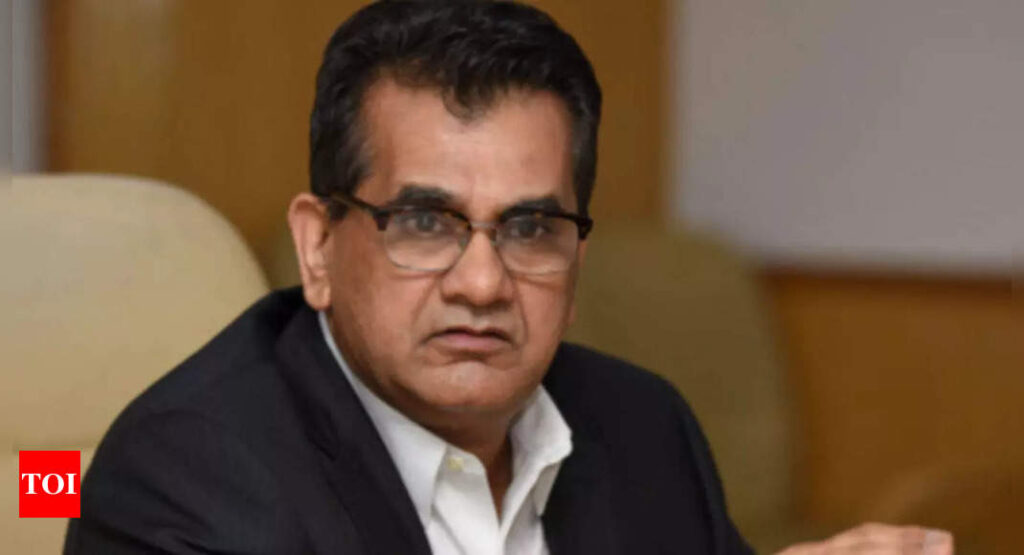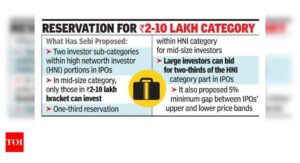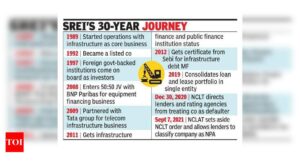National Monetisation Pipeline will protect interest of public, consumers: Kant – Times of India

[ad_1]
Amid political opposition and scepticism over the Rs 6 lakh crore asset monetisation plan, Niti Aayog CEO Amitabh Kant is confident of meeting the target and promises that consumers will be protected in sectors such as power and transfer of assets would be through well-defined structured contracts. Excerpts:
How is monetisation of assets under NMP different from privatisation, sale?
The modality and principles of monetisation of assets enumerated under NMP clarifies its clear distinction from privatization and sale. Under privatization or sale of assets, the private sector is the whole-sole owner of a business or asset, enjoying complete autonomy over the future sale of such assets, with no control or oversight from the government on universal availability of services, affordability for consumers and the standards of service delivery. Under sale or privatization, the private proponent owns the asset for perpetuity with no potential for buy-back or hand-back of assets.
For mechanisms proposed under NMP, monetisation of assets is by way of structural contractual partnerships, similar to public-private partnership projects which have now been undertaken for almost 20 years in the country. Well-defined contractual frameworks ensure redressal of challenges including protection of interests of the public and common citizens.
How confident are you of meeting the yearly target, particularly this year?
Ever since the announcement of the ‘Asset Monetisation’ programme in the 2021-22 Budget, NITI Aayog has been working with infrastructure ministries and the finance ministry. Extensive consultations has been undertaken with major stakeholders–public asset owners, private investors to prepare a realistic roadmap for the programme keeping intact the principles of public welfare, empowerment of vulnerable sections and socio-economic development at the heart of the exercise. NMP, which has been prepared only in 4-5 months, has been the first step towards it.
Work for rolling out of initially identified assets has already been undertaken by certain ministries. Of the assets identified for FY 2022, Powergrid has launched its first public sector InvIT, raising Rs 7700 cr. NHAI has also placed its draft offer document with the regulator and is currently in the advanced stages of the transaction. Various other sectors such as natural gas pipelines, railways, ports, airports are in advanced stages of approval or bidding. We are, hence, confident of achieving our targets for the current as well as future years.
In sectors such as power how are you going to ensure that private parties which come do not burden the consumers?
The ultimate objective of ‘Asset Monetisation’ programme is to create a win-win for all stakeholders including public authority, private investors and most of all the common citizen, through universal access to high quality and affordable infrastructure. Keeping in line with this guiding principle, monetisation of assets under NMP is envisaged as structured contractual partnerships. Transfer of rights/ assets will be defined by a clear contractual framework, which in line with the principles of model concession frameworks for PPP projects, will ensure standards of service delivery, protection of consumers and regulation/forbearance, to extent applicable for a sector.
Why is there reluctance to sell off hotel assets outright?
Assets identified under the NMP are expected to be rolled out through a range of instruments. Specifically for hospitality assets, the report on NMP, has identified models such as PPP concession, long term leasing and disinvestment among others.
While the government is committed to its policy of ensuring minimal presence in non-strategic sectors, divestment of all such assets may not be possible. This is on account of multiple factors such as location, utilisation as also the preservation of generational equity in assets such as land, wherever this is deemed necessary. There, is no one model fits all concept.
Is the NMP an exercise in bridging the fiscal deficit?
The strategic objective of the Asset Monetisation programme is to unlock the value of investments in public sector assets by tapping private sector capital and efficiencies, which can thereafter be leveraged for augmentation/greenfield infrastructure creation.
While one of the objectives is to improve the fiscal headroom through innovative financing alternatives, this is not an end in itself. This, in fact, is an overall strategy for (i) bringing about a paradigm shift in infrastructure O&M and augmentation (ii) creation of infrastructure investment alternatives for institutional investors such as insurance funds, pension funds, sovereign wealth funds (iii) enabling retail investors to invest in specialised infrastructure assets through instruments such as InvIT’s.
How confident are you of investor interest across such varied sectors?
Considering that assets targeted under NMP are de-risked brownfield assets with stable revenue generation profile, I am reasonably confident of investor interest.
Further, with the potential for monetisation by way of capital market instruments such as InvIT etc. I believe this is an opportune moment for launching transactions around such models, so as to ensure maximization of accruals. The key here being the right structuring, balanced risk-sharing framework and flexibility to deploy innovative business models.
Do you see implementation as a huge challenge in meeting the timelines?
Implementation is a critical aspect under NMP given the imperative for optimal structuring, time required towards approvals and clearances, as also in aspects such as ensuring the timing of transactions etc. Successful implementation of NMP, hence, hinges on an effective governance framework with escalation matrix for real-time monitoring of progress. This, hence, requires streamlining of frameworks and modalities in a manner which can be readily operationalised, adopted and replicated.
Monitoring of programme will be ensured through the asset monetisation dashboard, as envisaged under Union Budget 2021-22. The government, as part of a multi-layer institutional mechanism has constituted an empowered Core Group of Secretaries on Asset Monetization (CGAM) under the chairmanship of the Cabinet
Secretary for overall implementation and monitoring of the programme.
How is monetisation of assets under NMP different from privatisation, sale?
The modality and principles of monetisation of assets enumerated under NMP clarifies its clear distinction from privatization and sale. Under privatization or sale of assets, the private sector is the whole-sole owner of a business or asset, enjoying complete autonomy over the future sale of such assets, with no control or oversight from the government on universal availability of services, affordability for consumers and the standards of service delivery. Under sale or privatization, the private proponent owns the asset for perpetuity with no potential for buy-back or hand-back of assets.
For mechanisms proposed under NMP, monetisation of assets is by way of structural contractual partnerships, similar to public-private partnership projects which have now been undertaken for almost 20 years in the country. Well-defined contractual frameworks ensure redressal of challenges including protection of interests of the public and common citizens.
How confident are you of meeting the yearly target, particularly this year?
Ever since the announcement of the ‘Asset Monetisation’ programme in the 2021-22 Budget, NITI Aayog has been working with infrastructure ministries and the finance ministry. Extensive consultations has been undertaken with major stakeholders–public asset owners, private investors to prepare a realistic roadmap for the programme keeping intact the principles of public welfare, empowerment of vulnerable sections and socio-economic development at the heart of the exercise. NMP, which has been prepared only in 4-5 months, has been the first step towards it.
Work for rolling out of initially identified assets has already been undertaken by certain ministries. Of the assets identified for FY 2022, Powergrid has launched its first public sector InvIT, raising Rs 7700 cr. NHAI has also placed its draft offer document with the regulator and is currently in the advanced stages of the transaction. Various other sectors such as natural gas pipelines, railways, ports, airports are in advanced stages of approval or bidding. We are, hence, confident of achieving our targets for the current as well as future years.
In sectors such as power how are you going to ensure that private parties which come do not burden the consumers?
The ultimate objective of ‘Asset Monetisation’ programme is to create a win-win for all stakeholders including public authority, private investors and most of all the common citizen, through universal access to high quality and affordable infrastructure. Keeping in line with this guiding principle, monetisation of assets under NMP is envisaged as structured contractual partnerships. Transfer of rights/ assets will be defined by a clear contractual framework, which in line with the principles of model concession frameworks for PPP projects, will ensure standards of service delivery, protection of consumers and regulation/forbearance, to extent applicable for a sector.
Why is there reluctance to sell off hotel assets outright?
Assets identified under the NMP are expected to be rolled out through a range of instruments. Specifically for hospitality assets, the report on NMP, has identified models such as PPP concession, long term leasing and disinvestment among others.
While the government is committed to its policy of ensuring minimal presence in non-strategic sectors, divestment of all such assets may not be possible. This is on account of multiple factors such as location, utilisation as also the preservation of generational equity in assets such as land, wherever this is deemed necessary. There, is no one model fits all concept.
Is the NMP an exercise in bridging the fiscal deficit?
The strategic objective of the Asset Monetisation programme is to unlock the value of investments in public sector assets by tapping private sector capital and efficiencies, which can thereafter be leveraged for augmentation/greenfield infrastructure creation.
While one of the objectives is to improve the fiscal headroom through innovative financing alternatives, this is not an end in itself. This, in fact, is an overall strategy for (i) bringing about a paradigm shift in infrastructure O&M and augmentation (ii) creation of infrastructure investment alternatives for institutional investors such as insurance funds, pension funds, sovereign wealth funds (iii) enabling retail investors to invest in specialised infrastructure assets through instruments such as InvIT’s.
How confident are you of investor interest across such varied sectors?
Considering that assets targeted under NMP are de-risked brownfield assets with stable revenue generation profile, I am reasonably confident of investor interest.
Further, with the potential for monetisation by way of capital market instruments such as InvIT etc. I believe this is an opportune moment for launching transactions around such models, so as to ensure maximization of accruals. The key here being the right structuring, balanced risk-sharing framework and flexibility to deploy innovative business models.
Do you see implementation as a huge challenge in meeting the timelines?
Implementation is a critical aspect under NMP given the imperative for optimal structuring, time required towards approvals and clearances, as also in aspects such as ensuring the timing of transactions etc. Successful implementation of NMP, hence, hinges on an effective governance framework with escalation matrix for real-time monitoring of progress. This, hence, requires streamlining of frameworks and modalities in a manner which can be readily operationalised, adopted and replicated.
Monitoring of programme will be ensured through the asset monetisation dashboard, as envisaged under Union Budget 2021-22. The government, as part of a multi-layer institutional mechanism has constituted an empowered Core Group of Secretaries on Asset Monetization (CGAM) under the chairmanship of the Cabinet
Secretary for overall implementation and monitoring of the programme.
[ad_2]
Source link







